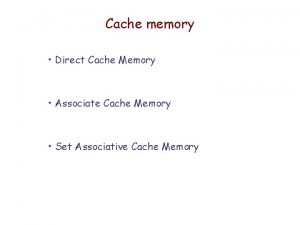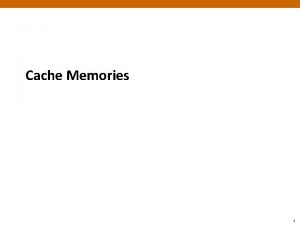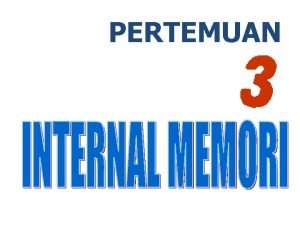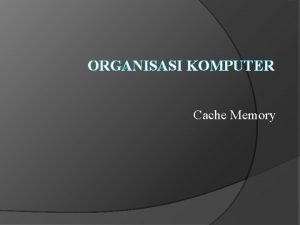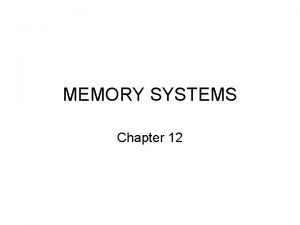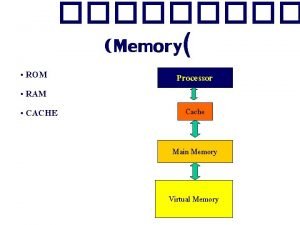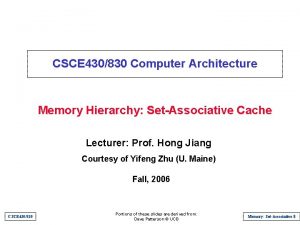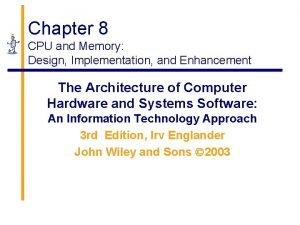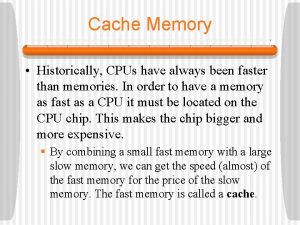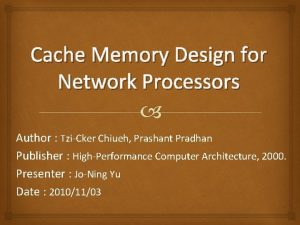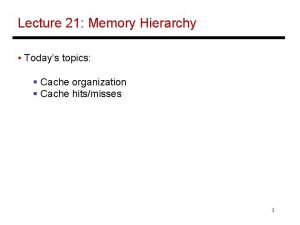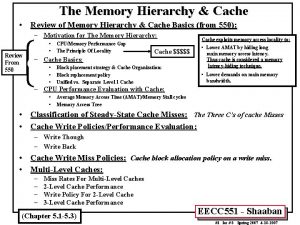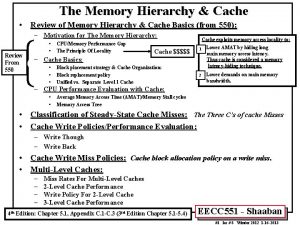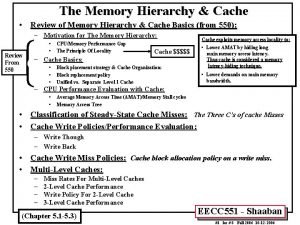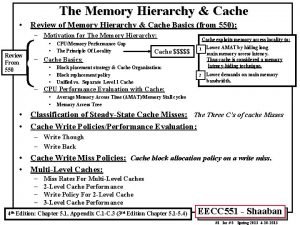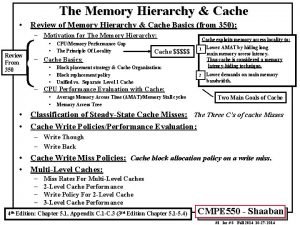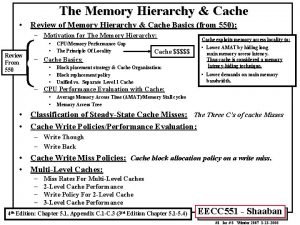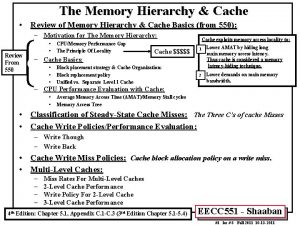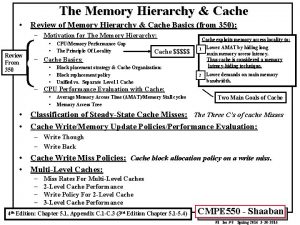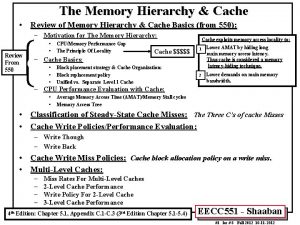Lecture 21 Memory Hierarchy Todays topics Cache organization















- Slides: 15

Lecture 21: Memory Hierarchy • Today’s topics: § Cache organization § Cache hits/misses 1

Cache Hierarchies • Data and instructions are stored on DRAM chips – DRAM is a technology that has high bit density, but relatively poor latency – an access to data in memory can take as many as 300 cycles today! • Hence, some data is stored on the processor in a structure called the cache – caches employ SRAM technology, which is faster, but has lower bit density • Internet browsers also cache web pages – same concept 2

Memory Hierarchy • As you go further, capacity and latency increase Registers 1 KB 1 cycle L 1 data or instruction Cache 32 KB 2 cycles L 2 cache 2 MB 15 cycles Memory 1 GB 300 cycles Disk 80 GB 10 M cycles 3

Locality • Why do caches work? § Temporal locality: if you used some data recently, you will likely use it again § Spatial locality: if you used some data recently, you will likely access its neighbors • No hierarchy: average access time for data = 300 cycles • 32 KB 1 -cycle L 1 cache that has a hit rate of 95%: average access time = 0. 95 x 1 + 0. 05 x (301) = 16 cycles 4

Accessing the Cache Byte address 101000 Offset 8 -byte words 8 words: 3 index bits Direct-mapped cache: each address maps to a unique cache location. Sets Data array 5

The Tag Array Byte address 101000 Tag 8 -byte words Compare Direct-mapped cache: each address maps to a unique address Tag array Data array 6

Example Access Pattern Byte address 101000 Assume that addresses are 8 bits long How many of the following address requests are hits/misses? 4, 7, 10, 13, 16, 68, 73, 78, 83, 88, 4, 7, 10… Tag 8 -byte words Compare Direct-mapped cache: each address maps to a unique address Tag array Data array 7

Increasing Line Size A large cache line size smaller tag array, fewer misses because of spatial locality Byte address 10100000 Tag array 32 -byte cache line size or block size Offset Data array 8

Associativity Byte address Set associativity fewer conflicts; wasted power because multiple data and tags are read 10100000 Tag array Way-1 Compare Way-2 Data array 9

Associativity Byte address 10100000 Tag array How many offset/index/tag bits if the cache has 64 sets, each set has 64 bytes, 4 ways Way-1 Compare Way-2 Data array 10

Example • 32 KB 4 -way set-associative data cache array with 32 byte line sizes • How many sets? • How many index bits, offset bits, tag bits? • How large is the tag array? 11

Cache Misses • On a write miss, you may either choose to bring the block into the cache (write-allocate) or not (write-no-allocate) • On a read miss, you always bring the block in (spatial and temporal locality) – but which block do you replace? Ø no choice for a direct-mapped cache Ø randomly pick one of the ways to replace Ø replace the way that was least-recently used (LRU) Ø FIFO replacement (round-robin) 12

Writes • When you write into a block, do you also update the copy in L 2? Ø write-through: every write to L 1 write to L 2 Ø write-back: mark the block as dirty, when the block gets replaced from L 1, write it to L 2 • Writeback coalesces multiple writes to an L 1 block into one L 2 write • Writethrough simplifies coherency protocols in a multiprocessor system as the L 2 always has a current copy of data 13

Types of Cache Misses • Compulsory misses: happens the first time a memory word is accessed – the misses for an infinite cache • Capacity misses: happens because the program touched many other words before re-touching the same word – the misses for a fully-associative cache • Conflict misses: happens because two words map to the same location in the cache – the misses generated while moving from a fully-associative to a direct-mapped cache 14

Title • Bullet 15
 Virtual memory and cache memory
Virtual memory and cache memory Cache read operation flowchart
Cache read operation flowchart Cache memory organization
Cache memory organization Virtual memory in memory hierarchy consists of
Virtual memory in memory hierarchy consists of Cache hierarchy error
Cache hierarchy error Karakteristik memori
Karakteristik memori Contoh cache memory
Contoh cache memory Cache set associative mapping
Cache set associative mapping Rom ram cache
Rom ram cache The disadvantage of direct cache mapping is
The disadvantage of direct cache mapping is How to calculate cache miss rate
How to calculate cache miss rate Computer memory system overview
Computer memory system overview Cache vs memory
Cache vs memory Cache memory is faster than
Cache memory is faster than Cache memory design
Cache memory design Karakteristik write through didalam write policy
Karakteristik write through didalam write policy

